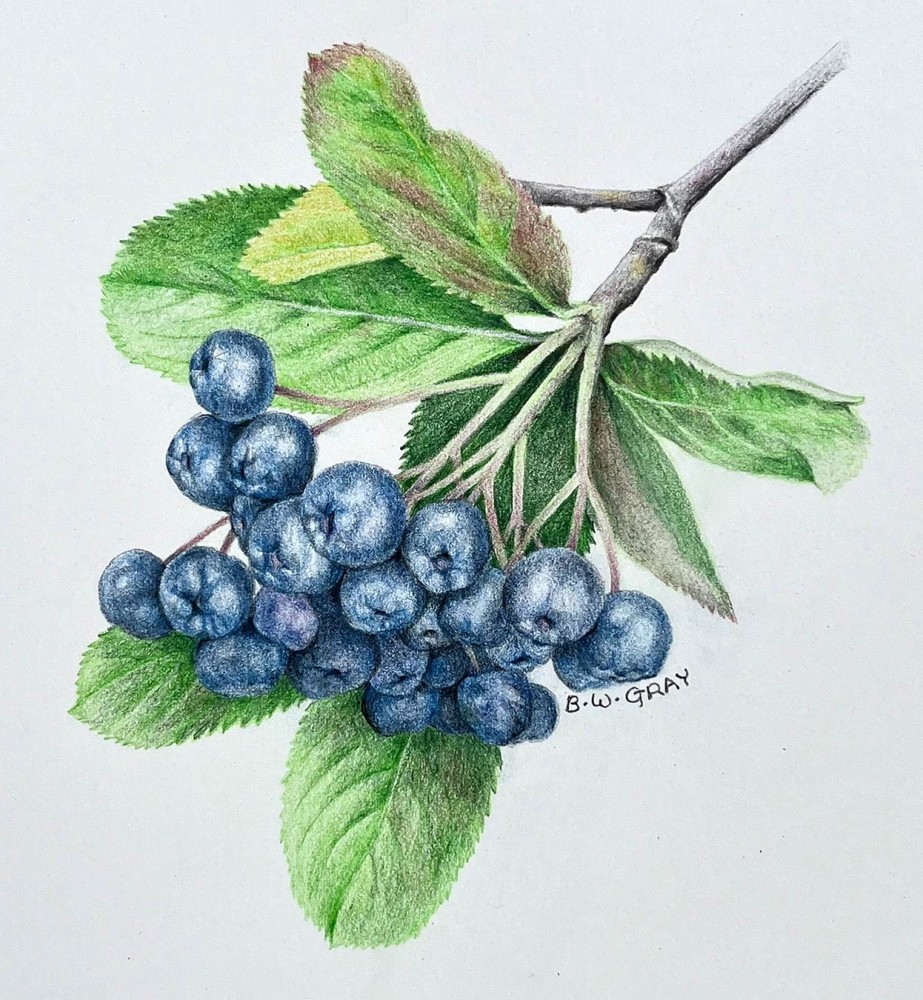Here’s a botanical riddle: What has fruits that look like a juneberry, flowers that look like a blackberry, leaves that look like an apple, and a name that sounds like a cherry? Answer: The latest health food supplement and a favorite juice of foragers in the know. I’m talking about Aronia melanocarpa, the black chokeberry.
Chokeberries are not chokecherries. They’re not like cherries at all. But the similarity in their names has led to ongoing confusion. Chokeberries are shrubs with alternate, simple, short-stalked, and finely toothed leaves. They remind me a bit of the leaves of an apple tree, but glossier and more oval in shape. In late spring, their fragrant blackberry-like flowers have five symmetrical white petals and grow in flat topped clusters. By late summer, those flowers mature into fleshy black fruits that look (but don’t taste) like juneberries. These fruits aren’t berries at all. They are more like miniature apples with tiny, seedy cores.
There are several plants that look similar to chokeberries. (The chokecherry is not one of them.) These include buckthorns, both native and introduced, the closely related mountain ash, and – depending on which part of the plant you see – blackberries, apples, or juneberries. Fortunately chokeberries have two unique tells. First, the tops of the leaves have minute, dark glands along both sides of the midrib. (Look closely.) Second, the scales on their buds have little notches at the tip. (These traits are also diagnostic for another, more southerly species, red chokeberry (Aronia arbutifolia) with red fruit that I’ve never eaten, but that purportedly has similar uses.)
Chokeberries often spread by underground stems, and you may find them growing as dense thickets. They prefer acidic, wet, sandy soils and often grow in bogs and on lakeshores. But they tolerate a wide range of conditions. Lately, I’ve noticed chokeberries planted as attractive landscaping shrubs in lawns and yards. They’re especially noticeable in fall, when their leaves turn a gorgeous flame red.
In my area, the berries usually come ripe in September. They are relatively quick to gather, but I recommend collecting several gallons if you plan to juice them. The berries have a soft, mealy texture and are only moderately juicy. Some foraging experts mention a bitter flavor, but I have never had bitter chokeberries.
The fruits can be eaten raw, but most foragers juice them. Instead of cold pressing, consider blending the fruits in a little bit of water and then straining the mixture through a jelly bag or cheesecloth. Another possibility is to use a cider press. I have also had success with squeezing the berries in a potato ricer. In about 20 minutes, I can squeeze about 5 cups of juice out of a gallon of berries.
The result is only slightly sweet, a little sour, and mildly astringent – similar to cranberry juice or a dry wine. The color is dark purple, almost black. I have a sweet tooth, so I like to mix chokeberry juice with apple or other juices. It also makes a great addition to smoothies or ice cream. With pectin, you can turn chokeberry juice into a beautifully colored jelly.
At health food stores, you’d pay $1.25 for an ounce of this antioxidant-rich superfood. But why pay someone else to go out walking by the lake on a warm, end-of-summer day to pick berries in the sunshine, when you could do it yourself?


